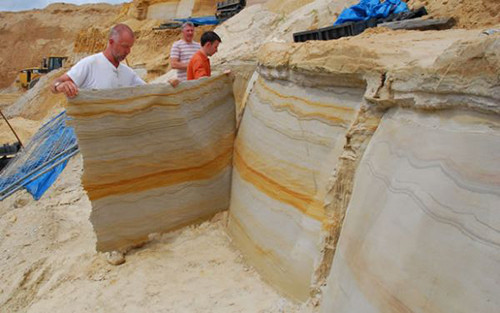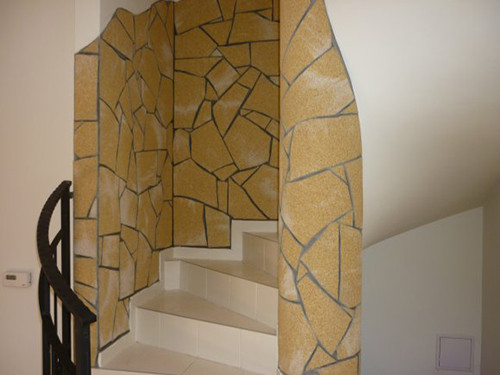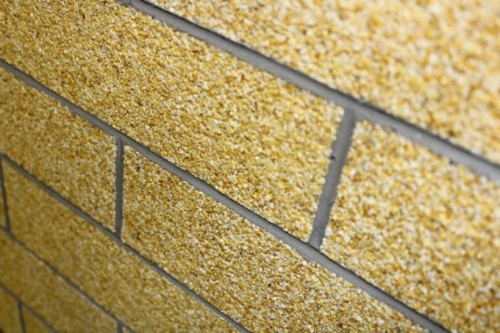Flexible stone is an innovative decoration material that has already earned the respect and love of designers. The low cost and ease of installation, coupled with excellent operational characteristics, allow it to be used both inside the house and for facing faces. In this article, we will consider in detail the technology of manufacturing and installation of flexible stone.
Content
Flexible stone characteristics
The technology for making flexible stone was invented in Germany a little over 10 years ago, and in Russia it appeared recently. Despite this, the material immediately gained popularity, which is not surprising - the coverage of flexible stone has a lot of advantages. It is suitable for decorating all kinds of surfaces - walls, floor, ceiling, columns, furniture, facades, stairs, etc.
The advantages of the material is flexible stone:
- Functionality - a small thickness (up to 4 mm) allows you to use a flexible stone for facing any surfaces, including rounded, angular, non -standard shapes.
- The ability to withstand high humidity and direct contact with water provides new opportunities for decorating bathrooms, pools, kitchens, etc.
- A flexible stone is made of natural minerals, so it is completely safe from the point of view of ecology (can be used in the children's room).
- The form of release is tiles and sheets, so that the installation is very simple and fast.
- A special structure makes it possible to create seamless coatings that mimic a whole surface from a monolithic stone slab.
- A flexible stone is easy to cut with an office knife or scissors.
- Absolute fire safety - the material does not burn and does not support combustion. For this reason, it is chosen for decoration of stoves and fireplaces.
- Simple care - it is easy to wash with ordinary water and a sponge, so if small children live at home, they can not forbid them to draw on the walls.
- Immunity to temperature jumps, which allows the use of material for external decoration even in the northern regions of the country.
- The uniqueness of the drawing - a special production technology excludes template. With all the desire, it will not be possible to make two identical drawings, which speaks only in favor of uniqueness and naturalness. The natural color scheme exactly imitates surfaces made of natural stone, of course, if the source material (baby) is not painted with pigments.
- Another unique property of flexible stone is light permeability. They can paste floor lamps or make disguised lighting sources in the room - the rays will break through the surface, giving soft soothing light.
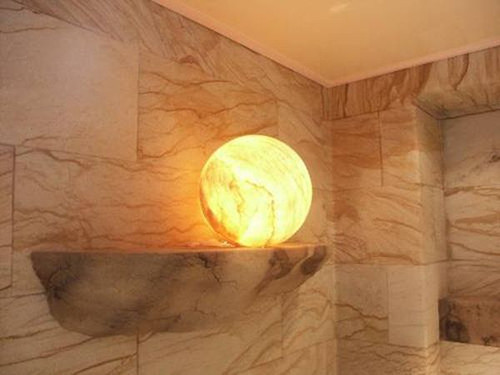
- You can apply photo printing on it, which further expands the boundaries of its decorativeness.
Making flexible stone
As we have already said, a flexible stone is a relatively new building material invented in Germany. The specific technology of its manufacture could be explained by German practicality or European frugality, but the fact is that a flexible stone allows you to get a strong, durable, beautiful and natural coating, while saving natural resources.
There are two methods of manufacture: in quarries and in the workshop. By the workshop, we mean both large factories and modest home production. In the first case, during excavations in the quarries, a flat cut of sandstone is made, cover it with a gauze canvas, impregnated it with glue and carefully cut it off after drying. The thickness of the layer of the material is from 1 to 3 mm, therefore, such a filigree work requires a special high -precision technique. As a result, a natural pattern, conceived by nature and formed several thousand years ago, remains on the canvas. Clay forms brownish and red stains, iron oxides give saturated brown shades, sandstone - yellow tones, etc.
As for the production of flexible stone with your own hands, it will be necessary to show imagination and create patterns yourself.
For the production of flexible stone, the following tools and materials will be needed:
- Mixing device - installation consisting of a construction mixer and a large capacity. For the manufacture of small parties, you can use the usual perforator with a mixer nozzle.
- Natural marble baby, sandstone or quartz sand. To make a multi -colored coating, bulk material can be painted with iron oxides. This is one of the most stable, durable and natural dyes that can be used for exterior decoration.
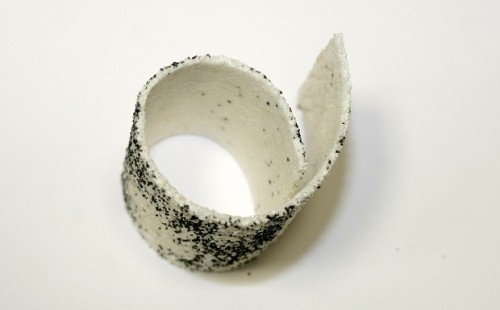
- Acrylic glue for impregnation and fixing stone crumbs. Acryl is characterized by high flexibility and elasticity, and in some cases, polymers and plasticizers are added to strengthen these qualities.
- The basis on which stone crumbs will be fixed. In this case, fiberglass is most suitable, because it is characterized by high strength, good adhesion with adhesive compositions and flexibility.
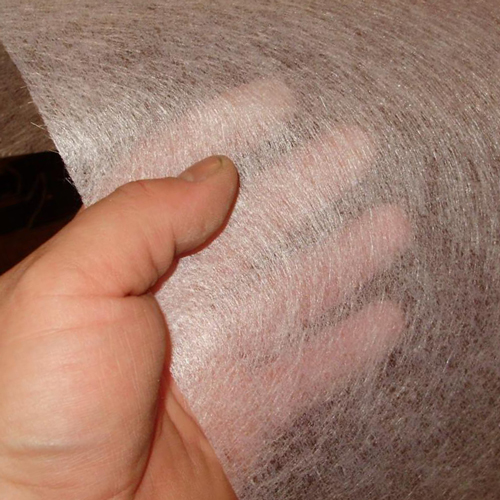
It is recommended to work on a wide table in good light. Sandy crumbs are applied to the reinforcing canvas (fiberglass) and impregnated with adhesive composition (acrylic resins), and then aligned and sent to dry. Drying raw sheets of flexible stone is recommended in a separate well -ventilated room, spreading them on wooden racks. To save space, you can make pallets with your own hands from OSB sheets and bars on sides 10-15 cm wide. So they will be folded on each other, leaving a sufficient gap for stable ventilation and drying of a flexible stone.
Flexible stone: installation technology
One of the main features of flexible stone, as finishing material, is that with its help you can create a whole seamless coating. To work, you need a plastic and gear spatula with 3 mm teeth, a rubber roller, a building hair dryer and a stationery knife.
In addition to the finishing material itself, stock up with acrylic glue (can be universal), if you leave the seams (wild stone effect), buy a grout. In some cases, it may be necessary to fill out the gaps between the lined surface and the floor (ceiling) - use transparent acrylic sealant for this. To improve adhesion with the base, treat it with a primer penetration.
Installation features:
- A flexible stone can be glued to any surface, but it is better if it is even and smooth - then the finish will look more spectacular. If there is no way to align the base, or this does not provide for the design, just clean it from the previous coating and dust.
- If finishing work is held in a room with a high level of humidity, the walls are recommended to be treated with deep penetration waterproof plaster. It can be bought in a store or make it with your own hands from the construction glue of PVA, cement and water.
- A flexible stone can be glued to uneven walls, but if there are shitty and downed corners, it is better to recover them first, otherwise the finish will last less than the required.
- After preparing the base, cover it with a primer to improve adhesion and wait for its drying.
- When using flexible stone in rolls, it is recommended to apply glue on the wall, in other cases, lubricate the back surface of the material. Apply a small amount of glue and distribute it with a gear spatula. Work with rolled stone, by and large, is no different from gluing ordinary wallpapers.
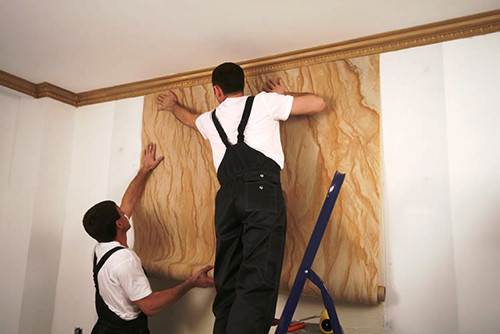
- Attach stone tiles to the wall and roll over the entire area with a rubber roller. The cladding of interior items (columns, lamps, etc.) should be made in small fragments so that they can be easily held when gluing for a couple of minutes.

- For facing the corners, a flexible stone is heated by a construction hairdryer, bend and glue close to the wall. High temperature melts acrylic resin, holding stone crumbs and does not allow the material to crack. When the tile cools, it retains the form that was given to it when bending. As a result, you get neat corners without joints.

- By the way about the joints - if you want to make a monolithic “stone” wall, just draw the seams with a small segment of sandpaper or the same flexible stone. When rubbing, the baby exfoliates and fills the joint between the elements, making it invisible. There is another way of eliminating seams - hot. To do this, the sheets of the material are laid with a small overlap, after which the junction of the joint is heated until a thick mass of acrylic with crumbs is formed. This mass is quickly aligned with a spatula, and the surface freezes without a seam.
Video about flexible stone and installation features:
- If glue performed between the tiles, immediately remove it with a rubber spatula and wipe this place with a wet rag.
- The grout of the seams with special compounds or sealant is carried out in the same way as when laying ceramic tiles, that is, after the glue is completely dry.
- You can remove the protective film from the surface of the stone only after the completion of all finishing and paintwork in the room.

- At the end, the lined surface should be treated with a water -repellent primer, which forms an impenetrable protective film that protects the stone from the negative effects of the environment. It is better to primer in two layers, applying the second after the previous one completely dry (should pass at least 2 hours). As an alternative to a primer, you can use a transparent varnish.
Wild stone
This is a special technology for installing flexible stone, which we decided to consider separately due to its specifics. The laying of the material under the "Wild Stone" is actively used for the decorative design of the facades of buildings, fences, and the interior decoration of the premises. It allows you to create an imitation of a wall laid out of unprocessed boulders, and from that is reliable and durable.
To create an original interior in the house, a “wild stone” is also used. At the same time, it is not at all necessary to adhere to any strict forms and outlines-the “rude” forms will be, the more natural the wall will look.
How to finish the "wild stone":
- Prepare the base by removing the old coating and leaving if necessary.
- Turn the flexible stone and make markings on the back with a marker. Draw fragments of various wrong forms.
- Take the clerical knife or ordinary scissors and cut a flexible stone along the intended lines.
- Glue the elements to the wall in a chaotic order, leaving gaps between them several millimeters.
- Scheat the seams with a special composition.
- Cover the surface with hydrophobic primer or varnish.
Flexible stone care
Since the manufacture of flexible stone provides for the use of high -strength acrylic glue, mineral crumbs are very tight. In addition, after facing, the surface is covered with a water -repellent composition (primer or varnish). For these reasons, it is very easy to care for a flexible stone.
The surface is not at all afraid of moisture, so it is enough to wipe it with a damp cloth. Since the baby creates a certain roughness and ribbiness, such a cladding collects dust, so from time to time it can be vacuumed.
Over time, a varnish coating or waterproof primer wear out, so the wall must be updated. To do this, it is enough to wash it, re-cover with a protective composition and forget about it for another 5-7 years.
The technology for making flexible stone has appeared recently and is still being improved, so do not be afraid to make your own adjustments to it and use all kinds of additives. So, for example, for the faces cladding in the winter, plasticizers can be used that will not allow the glue to freeze. Staining marble crumbs in various colors will help to achieve the uniqueness and originality of the drawings, and photo printing will even allow you to create real masterpieces.
Flexible stone: photo
In conclusion, we suggest you see how designers use a flexible stone to decorate the interiors and outdoor decoration.

